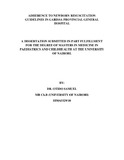| dc.contributor.author | Otido, S | |
| dc.date.accessioned | 2013-11-25T11:33:02Z | |
| dc.date.available | 2013-11-25T11:33:02Z | |
| dc.date.issued | 2013 | |
| dc.identifier.citation | A Dissertation Submitted In Part Fulfillment For The Degree Of Masters In Medicine In Paediatrics And Childhealth At The University Of Nairobi. | en |
| dc.identifier.uri | http://erepository.uonbi.ac.ke:8080/xmlui/handle/123456789/60002 | |
| dc.description.abstract | Background:
Appropriate resuscitation techniques are crucial to the survival of the newborn.
It is estimated that approximately 10% of newborns require assistance with
breathing at birth. The W.H.O guidelines for neonatal resuscitation have been
adopted by the Ministry of Health and it is recommended that all delivery room
personnel complete the Newborn Resuscitation Program (NRP) training in order
to improve the outcome of the resuscitation.
Justification:
Newborn resuscitation skills are mandatory to the all health workers who attend
to mothers in labour. These skills are acquired through training and frequent
practicing. No study has been conducted to assess the utilization of newborn
resuscitation guidelines in Garissa P.G.H.
Objective:
The aim of the study was to establish the level of adherence to the Newborn
Resuscitation guidelines by health workers in Garissa P.G.H.
Methods:
It was a descriptive hospital based cross- sectional study conducted in the labour
ward and the theatre departments of Garissa PGH. Thirty nine (39) health
workers were observed during resuscitation for a period of two months. Eleven
resuscitation steps were observed. To measure the level of adherence to the
guidelines, four initial basic steps were used to judge appropriate practice.
The health worker had to fully achieve them as follows; receive the baby in
warm towels, used a warm resuscitaire, positioned the baby in a neutral position
and assessed breathing in the newborn. A questionnaire was also administered
to establish barriers to effective resuscitation. Simple frequency tables were
generated for analysis of appropriate resuscitation practice and compared with
the health worker demographics. Multivariate logistic regression was used to
determine independent correlates of appropriate resuscitation practice.
Results:
From the 136 resuscitations observed, 26.5% (n=36) were performed
appropriately. The doctors were found to performed resuscitation more
appropriately than the nurses (OR 6.45, p=<0.001). The most commonly missed
steps were provision of warmth by use of warm towels (39%) and failure to
assess the newborn’s adequacy of breathing (39%).Of the 30 health workers
who responded to the questionnaire, 15 (50%) cited that lack of equipment
needed for resuscitation was the main barrier to effective newborn resuscitation.
Twelve workers (40%), reported lack of training in newborn resuscitation as the
main barrier.
Conclusion:
The basic newborn resuscitation practice according to the guidelines was poorly
adhered to at 26.5% of the cases observed.
Recommendations:
It is a possibility that emphasis on newborn resuscitation training and refreshers
courses for the health workers may be addressed to increase the adherence level
to the guidelines. | en |
| dc.language.iso | en | en |
| dc.publisher | University of Nairobi | en |
| dc.title | Adherence to newborn resuscitation guidelines in Garissa Provincial General Hospital | en |
| dc.type | Thesis | en |
| dc.description.department | a
Department of Psychiatry, University of Nairobi, ; bDepartment of Mental Health, School of Medicine,
Moi University, Eldoret, Kenya | |
| local.publisher | School of Medicine | en |

